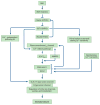Guard cell signal transduction network: advances in understanding abscisic acid, CO2, and Ca2+ signaling
- PMID: 20192751
- PMCID: PMC3056615
- DOI: 10.1146/annurev-arplant-042809-112226
Guard cell signal transduction network: advances in understanding abscisic acid, CO2, and Ca2+ signaling
Abstract
Stomatal pores are formed by pairs of specialized epidermal guard cells and serve as major gateways for both CO(2) influx into plants from the atmosphere and transpirational water loss of plants. Because they regulate stomatal pore apertures via integration of both endogenous hormonal stimuli and environmental signals, guard cells have been highly developed as a model system to dissect the dynamics and mechanisms of plant-cell signaling. The stress hormone ABA and elevated levels of CO(2) activate complex signaling pathways in guard cells that are mediated by kinases/phosphatases, secondary messengers, and ion channel regulation. Recent research in guard cells has led to a new hypothesis for how plants achieve specificity in intracellular calcium signaling: CO(2) and ABA enhance (prime) the calcium sensitivity of downstream calcium-signaling mechanisms. Recent progress in identification of early stomatal signaling components are reviewed here, including ABA receptors and CO(2)-binding response proteins, as well as systems approaches that advance our understanding of guard cell-signaling mechanisms.
Figures




References
LITERATURE CITED
-
- Acharya B, Assmann SM. Hormone interactions in stomatal function. Plant Mol Biol. 2009;69:451–62. - PubMed
-
- Albrecht V, Weinl S, Blazevic D, D’Angelo C, Batistic O, et al. The calcium sensor CBL1 integrates plant responses to abiotic stresses. Plant J. 2003;36:457–70. - PubMed
-
- Allen GJ, Chu SP, Harrington CL, Schumacher K, Hoffmann T, et al. A defined range of guard cell calcium oscillation parameters encodes stomatal movements. Nature. 2001;411:1053–57. - PubMed
RELATED RESOURCES
-
- Kwak JM, Mäser P, Schroeder JI. The clickable guard vell, version II: Interactive model of guard cell signal transduction mechanisms and pathways. In: Chang C, Graham I, Last R, McClung M, Weinig C, editors. The Arabidopsis Book. Am. Soc. Plant Biol; Rockville, MD: 2008. pp. 1–17. http://www-biology.ucsd.edu/labs/schroeder/clickablegc2/ - PMC - PubMed
Publication types
MeSH terms
Substances
Grants and funding
LinkOut - more resources
Full Text Sources
Other Literature Sources
Miscellaneous

